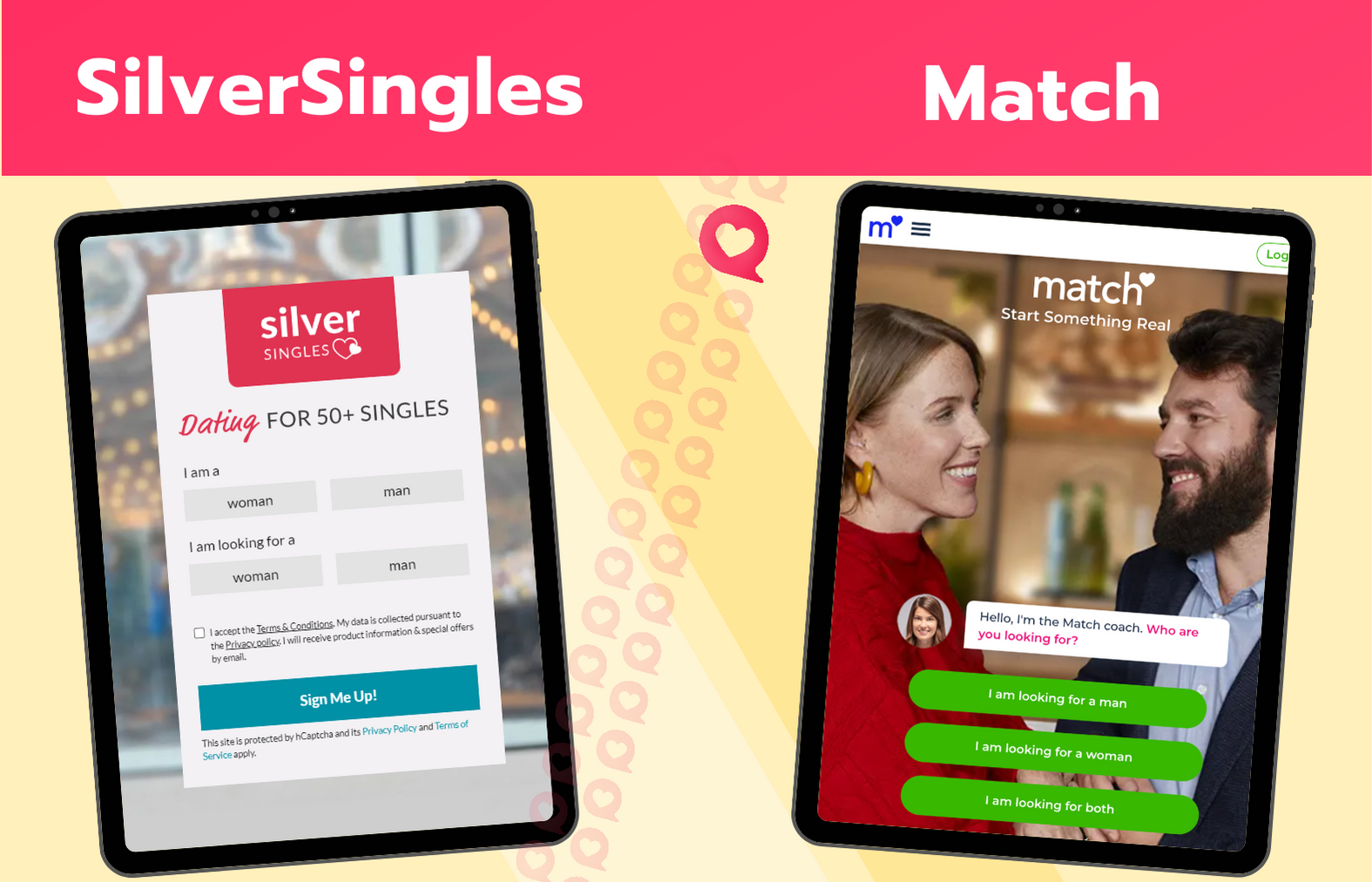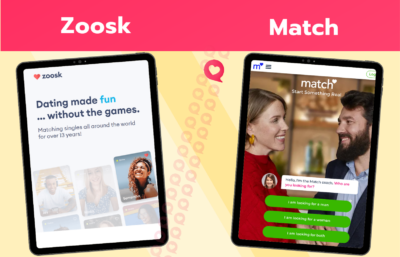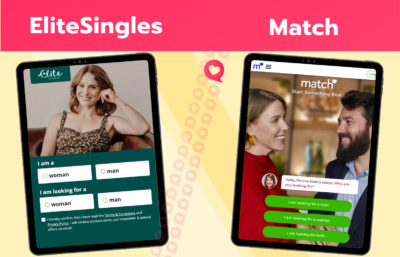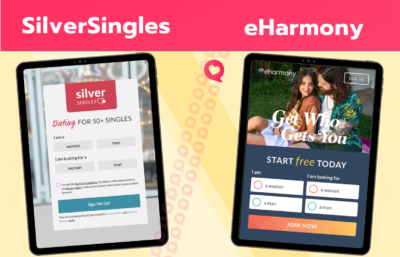SilverSingles vs. Match: Which Dating Site is Better?

The main difference between SilverSingles and Match.com is their target audience. Though it may seem that both sites work best for people seeking serious relationships and marriage, it’s important to consider that SilverSingles, unlike Match, is an exclusive site for mature singles aged 50+.
Navigating the dating scene can be a daunting task, especially when it comes to choosing the right platform. Two popular choices are SilverSingles, a haven for mature singles, and Match, a site renowned for creating more romantic connections than any other.
With SilverSingles boasting over a million users worldwide and Match being the first dating site ever, with millions of users across the globe, both offer unique experiences. But which one reigns supreme? Let’s find out!
Overall impression
After comparing both online dating platforms, SilverSingles is the better platform due to using intelligent matchmaking, an easy-to-use interface, and emphasizing the 50+ age group users.
Overview
| SilverSingles | Match |
|---|---|
| Specifically designed for singles aged 50 and over | A more general platform targeting singles of all age ranges |
| Convenient mobile apps are available on Google Play and App Store | Uses the details in your profile and your site activity to suggest matches |
| Uses a personality test to suggest highly compatible matches based on personality traits | Free users can send likes, but only paid members can send and receive messages |
| 3 subscription plans are available | Match Events are local events where members can meet in person in a group setting |
| Only paid members can send and receive messages | Claims to have led to more dates, relationships, and marriages than any other platform, but a percentage is unknown |
Key differences between SilverSingles and Match
- SilverSingles is specifically designed for singles aged 50 and over, while Match is a more general platform targeting singles of all ages (mostly 25-45 y.o.).
- Match allows free users to send likes, while SilverSingles doesn’t have this feature available for basic membership.
- SilverSingles uses a personality test to suggest highly compatible matches based on personality traits. On the other hand, Match uses the details in your profile and your site activity to suggest matches.
- Match offers a unique feature called Match Events—local events where members can meet in person in a group setting. At the same time, SilverSingles is focused on the senior user base, ensuring a mature dating environment.
What types of relationships are people seeking on SilverSingles and Match?
- Long-term Relationships. Many users are interested in finding a life partner, often after having been through previous long-term relationships or marriages.
- Companionship. Given the platform’s demographic (50+), many users look for companionship and someone to share their lives with.
- Friendship. Some users are seeking platonic relationships and looking to expand their social circles.
- Widowed/Divorced. Many users are widowed or divorced and are looking for a fresh start.
- Long-term Relationships. Many users on Match seek serious, long-term relationships.
- Marriage. Given its broad demographic, Match caters to people looking for potential marriage partners.
- Friendship. Some users are primarily interested in expanding their social circles and making new friends.
- Flirting/Chatting. Some users enjoy the flirting and chatting aspect of dating sites without necessarily looking for a committed relationship.
Comparison of SilverSingles and Match matching algorithms
| SilverSingles | Match |
|---|---|
| Uses a personality test, which informs the Five-Factor Model, a well-established psychological theory | Uses profile information and user activity |
| Factors include the degree of openness, conscientiousness, extraversion, agreeableness, and neuroticism | Factors include shared interests, lifestyle, physical characteristics, and value system |
| Sends a list of 3-7 potential matches daily based on the test | Provides new matches daily, the number can vary, and users can freely search profiles |
| Users can do a custom search in addition to their daily matches | Matchmaking is based on user activity, so it adapts over time |
| Matches are highly personalized based on the personality test | The matching algorithm is less flexible, relies more on initial user input, and doesn’t adjust as dynamically over time |
Pricing comparison
Let’s compare the costs and available features of both platforms.
Free features
| SilverSingles | Match |
|---|---|
| Creating the profile | Limited sending and receiving messages |
| Taking the personality test | Unlimited likes |
| Getting daily matches list | Up to 6 Picks daily |
| Browsing a limited number of suggested profiles | Monthly Boost |
| Sending ‘Smiles’ to other users | See who Super Likes the member |
Paid features
| SilverSingles | Match |
|---|---|
| Unlimited communication | Sending and receiving unlimited messages |
| Browsing all user photos | Unlimited likes |
| Receiving read receipts | Unlimited Rewinds |
| Viewing profile visitors | Weekly Super Like |
| Detailed personality profile review | Up to 12 Picks daily |
Cost and prices
| SilverSingles | Match |
|---|---|
| Users can choose among 3 paid subscriptions | Users can choose among free, standard, and premium plans |
| Users with different levels of income pay various costs | 3-month, 6-month, and 12-month paid subscriptions are available |
| Both males and females should buy a premium account to access extra features | Members can use gift cards and promo codes |
| A discount for a Premium Classic subscription is available | All paid plans automatically renew each payment period |
| The highest monthly price is $44.95/mo (for a 3-month premium plan) | The maximum premium plan cost is $40.41/mo |
Comparison of SilverSingles and Match user interface and design
| SilverSingles | Match |
|---|---|
| Minimalistic and clear interface | Neat and organized layout |
| Designed for ease of use, considering its target audience of 50+ | User-friendly design, but more complex features that may require some learning |
| Mobile apps are available for iOS and Android; similar functionality to the website | Apps for iOS and Android devices have almost identical functionality to the website |
| Features are easy to access and understand, with clear labels | Features are slightly more complex, with various search options and features |
| Simplicity in design, using larger fonts and clear, contrasting colors | Modern and sophisticated design with a combination of soft and striking colors |
Our editor’s conclusion

After an in-depth analysis of SilverSingles and Match, we’ve concluded that SilverSingles holds a slight edge for those seeking a more targeted, mature dating experience. Despite Match’s broad appeal and extensive user base, SilverSingles shines with its tailored approach, prioritizing quality over quantity.
Its intuitive interface, comprehensive personality test, and focused user base offer a comfortable and promising platform for those aged 50 and over. If you’re in this demographic and are seeking a long-term, meaningful connection, SilverSingles may just be the perfect platform for you.
FAQ
SilverSingles is designed specifically for singles aged 50 and over, while Match caters to singles of all ages. SilverSingles uses a personality test based on the Five-Factor Model of personality traits to suggest matches, while Match uses profile information and user activity. Only paid members can send and receive messages on both platforms, but Match allows free users to send likes.
Both SilverSingles and Match offer free memberships with limited features. A paid subscription is required to access all functionality, including unlimited communication with dating site members.
Both platforms are designed to help users find long-term relationships. However, SilverSingles, with its mature user base and compatibility test, may offer a better environment for users in the 50+ demographic seeking long-term companionship. That said, Match’s broad user base and adaptive matching algorithm provide a solid platform for users of all ages seeking long-term relationships. Success rates can depend heavily on the user’s personal efforts, preferences, and platform use.





I love to cook. My signature dish is homemade spaghetti and meatballs. I am lovely, friendly, trustworthy etc
i am Lovely, caring, trustworthy, friendly etc